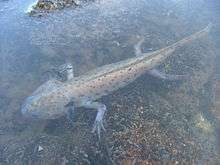Taylor's salamander
| Taylor's salamander | |
|---|---|
 | |
| Scientific classification | |
| Kingdom: | Animalia |
| Phylum: | Chordata |
| Class: | Lissamphibia |
| Order: | Caudata |
| Family: | Ambystomatidae |
| Genus: | Ambystoma |
| Species: | A. taylori |
| Binomial name | |
| Ambystoma taylori (Brandon, Maruska, and Rumph, 1982) | |
Taylor's salamander, Ambystoma taylori, is a species of salamander found only in Laguna Alchichica, a high-altitude crater lake to the southwest of Perote, Puebla, Mexico. It was first described in 1982 but had been known to science prior to that. It is a neotenic salamander, breeding while still in the larval state and not undergoing metamorphosis. The lake in which it lives is becoming increasingly saline and less suitable for the salamander, which is declining in numbers. The International Union for Conservation of Nature has rated it as being "critically endangered"
Taxonomy
It was described in 1982 by Brandon, Maruska, and Rumph, and named for Edward Harrison Taylor. However, the species had been known to science long before then. Taylor himself attempted to describe the species as Ambystoma subsalsum in 1943, but mistakenly used a Mexican or plateau tiger salamander as the holotype. This rendered the name invalid, and made it into a synonym for the tiger salamander. James Anderson extensively catalogued "A. subsalsum" in his 1960's field work, applying the name to actual population that now comprises A. taylori.
Ecology
The salamander is moderately sized, with a typical length of 6-8 in. It is a neotenic species, which means it retains its caudal fin and external gills into adulthood, never undergoing complete metamorphosis. It is entirely aquatic, breeding and laying its eggs in the same lake where it lives. Taylor's salamanders are yellowish in color, with dark spots along their dorsal sides. They have relatively short, thick external gill stalks. Their heads are quite large, and their limbs are underdeveloped, as in most Ambystoma neotenes. They feed by buccal suction, and basically eat anything that fits into their mouths.
Habitat
The A. taylori habitat in Lake Alchichica is extremely salty, with a salinity reading of 2000-5000. It is also very alkaline, with a pH of 8.5-10. The lake's water has a temperature range of 18-21 °C. The salamanders typically hide below the water line, under overhangs in the crater's edge.
Status
Lake Alchichica is becoming more saline as water is extracted for irrigation and drinking. The level of the lake has fallen and if this deterioration in water quality continues, this salamander is likely to become extinct. The International Union for Conservation of Nature has assessed the salamander's conservation status as being "critically endangered" and has proposed that a captive breeding programme be established.[1]
References
- 1 2 IUCN SSC Amphibian Specialist Group (2015). "Ambystoma taylori". IUCN Red List of Threatened Species. Version 2013.2. International Union for Conservation of Nature. Retrieved 19 January 2016.
- Edward H. Taylor (1943.) "A New Ambystomid Salamander Adapted to Brackish Water", Copeia, Vol. 1943, No. 3 (Oct. 15, 1943), 151-156. doi:10.2307/1438606.
